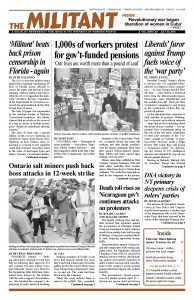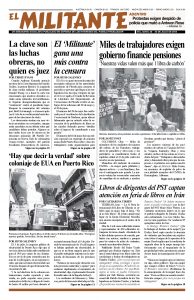With today’s upturn in capitalist production and trade, rail bosses are trying to hire thousands of workers this year. But in their drive for profits, the bosses are also running longer and longer freight trains with smaller and smaller crews and assembling trains by remote control in rail yards, endangering the safety of both rail workers and those who live and work near the tracks. Derailments are becoming more common.
Union Pacific, which operates in 23 states in the western two-thirds of the country, plans to hire 2,100 engineers and conductors and 900 mechanical positions. It offers hiring bribes of $10,000 and more to those who sign on, as well as retention bonuses for workers who agree to forego retirement and keep working.
BNSF Railway, which operates in 28 states, seeks to hire more than 3,500 workers, a spokesman said. And Norfolk Southern Railway in its 22-state network in eastern U.S. plans to hire 1,800. CSX, which operates in 23 eastern states and two Canadian provinces, has also begun to hire. The company has offered to buy personal leave and vacation time from trainmen this summer at a rate of 150 percent of normal pay for those who agree to work through their vacations and personal time.
Conductors and engineers at CSX, who didn’t want to give their names for fear of company retribution, told the Militant the railroad is working crews long hours with only the minimal rest required by law, and in some cases prohibiting conductors from using personal leave time over the entire summer. “I have not seen crews this fatigued before,” one worker said.
CSX recently fired some workers for taking time off for family medical responsibilities, intimidating others from marking off.
Shipments of consumer goods are rising. “We’re seeing almost every month a new record in the amount of trailers and containers we’re handling,” John Gray, the Association of American Railroads senior vice president, told the Chicago Tribune, “almost all of that is driven by consumer spending.” The largest single rail customer, he said, is UPS, which is having trouble finding enough drivers.
The bosses’ response to the jump in business has been assembling trains 2-to-3 miles long, which are more prone to derailments, oil spills and explosions from the flammable chemicals being transported. They’ve cut the number of workers on each train, and now are pushing for a one-worker “crew.” The long trains introduce dangerous communication problems for crews, as radio transmissions from rear to front often cut out at those distances.
Bosses are also cutting the size of their workforce in rail yards where trains are assembled. Conductors on the ground increasingly work using a “belt pack” or RCO — a remote control device to operate engines with no engineer aboard. In a number of cases, this has resulted in runaway trains and other disasters.
In June 2017, in Canadian National’s MacMillan Yard in Vaughan, Ontario, a foreman and his helper attempted to assemble a long train with a beltpack. “More and more cars rolled onto the downward slope of the outer edge of the yard,” CBC News reported. “Once about two-thirds of them rolled onto the main track, the workers could no longer keep the train in control.” The runaway train rolled over 3 miles at speeds up to 30 mph before stopping on an uphill stretch of track.
Among those responding to the new rail job openings are workers being drawn to re-enter the workforce — some 601,000 in June alone, according to the Labor Department. As a result, June’s official unemployment rate rose from 3.8 to 4 percent, as “discouraged” workers start looking for work and get listed on official unemployed rolls. The new hiring offers opportunities to strengthen the rail unions, advance the fight against smaller crews, and to fight for safer working conditions on and around the job.
Ever since the mid-1950s, rail bosses have been seeking to cut costs by reducing train crews. In the 1980s union contracts set the crew size at five, but bosses have been whittling this down to two, and in some cases one. In the early ’90s bosses offered substantial blood money payments to bribe crews to agree to cuts in crew size.
Workers fight dangerous conditions
Rail workers and their unions have fought back against attempts to impose one-person crews over the road. SMART union members at BNSF Railway overwhelmingly rejected company demands for one-person crews on freight trains in 2014.
In Lac-Mégantic, Quebec, where federal government officials agreed to demands by Montreal, Maine and Atlantic rail bosses seeking to save money to run trains with a one-person crew, a 72-car train full of highly flammable oil derailed and exploded as it rolled into the town in July 2013, killing 47 people. At the time the one-person crew, Tom Harding, was signed off for sleep, having worked his 12 hours that day.
“In the last five years, the number of these uncontrolled movements has been on the rise” said Faye Ackerman, a Transportation Safety Board member in Canada, at a recent news conference in Toronto.
On July 13, 27 freight cars derailed on the outskirts of Tucson, Arizona. Some 230,000 gallons of oil spilled out of 14 of 32 derailed tanker cars in northwest Iowa June 22. In Princeton, Indiana, a train derailed and exploded June 17, causing evacuation of the area. Two freight trains collided and derailed in Georgetown, Kentucky, March 18, injuring four and forcing evacuations. And 32 cars derailed on a CSX freight train carrying hazardous materials last August near Hyndman, Pennsylvania, and over 1,000 residents had to leave their homes.
An Amtrak train collided with a CSX freight train when it was mistakenly switched onto a siding in February in South Carolina, killing two workers on board the Amtrak engine.

